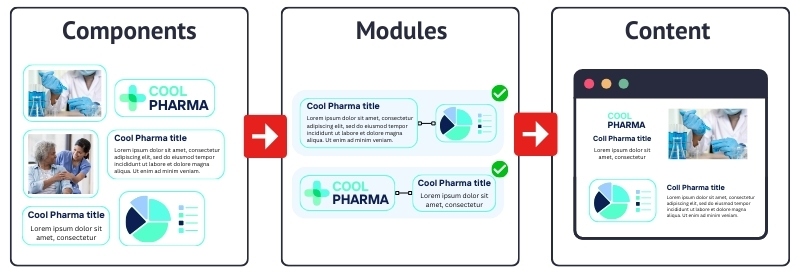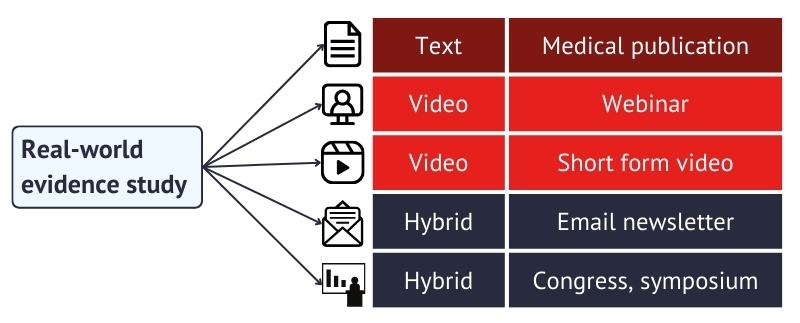Can you count how many times you’ve heard ‘modular content’ in the past year? Every pharma company and marketing agency has been obsessed with this buzzword, and rightly so. But even if you think you know what modular content is all about… you don’t. Not really.
One definition of modular content can vary drastically from the next. Is it all about mixing and matching content blocks? Or does it have more to do with using one block for different channels? Curveball: what if it’s both?
Let’s clear this all up. Welcome to our definitive guide to modular content in pharma!
Key Takeaways
What is Modular Content?
Most definitions of modular content can be split between building blocks and repurposing.
Modular Content as Building Blocks
The first modular content definition is best summarised by Veeva:
The process of creating pre-approved content blocks (also known as ‘modules’) that marketers can quickly and easily recombine into a variety of polished assets
Under this definition, there are:
- Components – written copy, images, facts or statistics from studies, etc.
- Modules – the relationship between components.
- Content – the finished piece of content containing multiple components.

Let’s say that your components include videos, text, images, graphics, and facts from a survey you conducted. Your modules are then tailored for each channel. For example, you need easy-to-digest yet eye-catching components for your social media channel. And finally, you can pull modules together to create a shareable infographic or carousel post for social media.
Modular Content as Repurposing
The other modular content meaning is all about repurposing existing content.
It’s like recycling applied to digital marketing, where you take one piece of content and turn it into different formats, like videos, summaries, or infographics.
Let’s take an example…
Here is what a traditional method might look like:
Conducting a survey → Writing this into a study → Publishing the scientific study on your blog.
Now with modular content, rather than having one piece of content for one purpose (eg. the study becomes a blog article), we repurpose it. So that study can be broken into singular facts, whole paragraphs, or just tables and charts, to be used for all kinds of marketing materials.

Which Version of Content Modules is Right?
In our opinion, both definitions are valid. And if you want to benefit fully from modular content then you need to incorporate both methods.
This means creating individual content modules to be mixed and matched, as well as identifying and breaking down existing content for repurposing.
The Advantages of Using Content Modules
When you incorporate modular content into your omnichannel pharma marketing strategy, you’ll find these benefits over traditional content production.
| Traditional | Modular |
|---|---|
| Each piece of content is created for a specific channel. | All content is designed to work across channels through repurposing. |
| Individual medical, legal and regulatory (MLR) approval for all content on each channel. | Single blocks are pre-approved first and then used across channels. No need for repeated MLR approval. |
| With so much content, it is hard to update and distribute it. | Update a single block and use it for all channels – continual updates made easy! |
| Results in slow reactivity to changes in audience needs, industry disruptions, etc. | Fast reactivity. Just find the module that needs to be updated and leave the rest. |
| Adapting content for local use is time-consuming. | Adapting for local use becomes more flexible, with only necessary modules being adjusted. |
| HCP customisation is very difficult, with entire emails, articles, and other points of contact being created from scratch. | Engagements can be customised, with modules mixed and matched depending on HCP preferences. |
To sum it up, modular content is a faster, more efficient and more effective way to deliver personalised content that’s pre-approved and ready to go.
How to Create a Building Block Modular Content Strategy
Let’s split this into four easy steps.
Prerequisite
Before you start making tangible changes, stop and think about it. Get everyone on the same page.
- Teach your team about modular content creation and what it entails.
- Ensure everyone understands your definition of it.
- Incentivise your team by showing how a switch from traditional content benefits them as well as your pharma marketing efforts (e.g. less time spent on menial updating tasks, more time for innovation).
- Create and clearly define your content goals and KPIs.
Set Up the Modular Content Platform
Next, create a system or platform to base your modular content marketing on.
- Set up a module library for digital asset management (DAM). Like a directory or album, this system has all the modules available to your team.
- Ensure your DAM system is accessible by your teams, with content clearly marked as ‘for review’ or ‘approved’ for MLR compliance.
- Define the modular structure per channel. Each channel will have unique templates, frameworks, and regulations that determine which modules can be utilised.
- Create a brand guide. This should outline the style, tone of voice, and do’s and don’ts for your brand, to keep all modular content consistent across your marketing efforts.
A well-known DAM solution used by many pharma companies as part of their modular content strategy is Veeva Vault Promomats. Thanks to Veeva’s focus on the Life Sciences market, they developed a solution that aims to facilitate global collaboration and the content approval process.
Assess the ‘Modularity’ of Existing Content
This is all about auditing existing content to see what can be utilised. For each individual piece of content, ask:
- Can it be broken down into components or modules?
- Is it performing well?
- Is it used broadly, in both a geographical sense and across your marketing channels/campaigns?
- Is it evergreen and will it remain relevant for the foreseeable future?
With all the usable content separated and saved, work on:
- Content categorisation, by type (image, text, etc.) and topic (different products, diseases, etc.)
- Identification of key ‘components’ that can be used as stand-alone modules (infographics, case studies, statistics, etc.)
Create the Modular Content
With clear directives, it’s time to jump in. Start to:
- Upload components and existing modules to your library.
- Create new modules based on available components and marketing objectives.
- Map component relationships, to explore how the different components can build on each other and be combined while following rules and regulations.
- Set a realistic content calendar and respect it.
- Combine your modules to create relevant content for your audience.
Optional: Start with a pilot programme to test the system and demonstrate efficiency with a few modular content examples. This will be useful for getting apprehensive team members onboard too.
How to Repurpose Content for Modular Content Marketing
This element of modular marketing is a little simpler – rather than creating new content, you’re reassessing previous campaign content.
Prerequisite
Similarly to the building blocks strategy, start with:
- Define your goals, especially as they are likely different to the goals you had when your content was initially created.
- Use your new goals (e.g. reach new audiences, increase brand visibility) to determine the formats and channel options you’ll use.
- Understand your audience segments. Different segments will have different preferences in terms of formats and channels, so have these in mind as you re-evaluate old content.
Content Selection
When selecting your content, prioritise content that is:
- Evergreen and relevant. Repurposing requires time and often creativity – use it for content that can be continuously repurposed and used for the long term.
- High-performing. No one wants to waste their budget on content that doesn’t work.
- Easy to transform into different formats and easy to split into smaller pieces.
Content Repurposing
Finally, let’s repurpose your content. For each piece of content:
- Identify the new format you want to change it into. E.g. turn a study into a short social media video.
- Consider the strengths and limitations of the format you want to repurpose your content into.
- Adapt your content to the new format. You cannot just read the study in front of the camera!
- Don’t be cheap as you adapt. If you don’t have the skills in-house to create an engaging video, go for an agency. Alternatively, consider formats that you do have the skills for.
- Adapt your format again to different channels. The same video format doesn’t work on each channel.
Even if you aren’t following our example of turning a study into a video, try to make things visual. This makes it highly shareable and engaging. So, fill your blog with infographics and repurpose blocks of text in other visual formats.
The Importance of a Visual Content Calendar
At phamax Digital, we find having a visual content calendar to be absolutely vital. This applies to traditional content, but even more so for modular content. With your content broken into smaller components and modules, maintaining an effective overview has numerous benefits.
It provides a clear content landscape where you can view all modules available. This also shows you how they fit together best.
It maintains consistency. As each module is interconnected, the schedule stays consistent. This enhances coherent storytelling, mitigates gaps, and aligns all content with both segment customisations and the overall marketing goals.
It enables adaptable strategic planning. So, you can flex to seasonality, trends and events in advance, or incorporate feedback and new business priorities. This helps you keep content relevant and take advantage of optimal timings.
It improves resource planning too. Contributors, whether they’re in-house or external agencies, repurposing content or creating new content, can stick to roles and deadlines in the calendar.
Creating a Visual Calendar for Modular Content
You can create a modular content management system calendar with a Google Sheet or Excel Spreadsheet. You’ll find endless marketing content creation templates online. To make your calendar visual, we recommend:
- A new tab for each month, to avoid endless scrolling.
- Making each cell large and square, like an old-school paper calendar. Wrap text, so it’s all visible.
- Use colour coding that matches the organisation of your modular components.
The Main Challenges of Modular Content
Modular content is a sizable change from traditional strategies. While we think it is worth it, there are some challenges you’ll face:
You must maintain scientific accuracy to avoid inconsistencies across modules.
Version control is challenging in fast-moving pharma. All channels and localised teams must use the latest, approved versions of modules.
Collaboration, often a weakness of pharma companies, is essential between different departments.
Maintaining data security and privacy is tougher with modular content tailored to different platforms.
Adapting content for global vs local markets and regulations is tough with so many modules.
The training and mentality shift, going from traditional to modular content creation, can be tough for large pharma companies with old-school teams. New modular content tools and strategies take time to master.
Measurement is notably more complex than with traditional content. The success of a piece of content could be due to one or multiple components, rather than just the overall piece.
Conclusion
Switching from a traditional to a modular content framework for pharma is effective. With a modular system in place, creating new content takes a matter of hours rather than days. The real barrier, however, is the upfront time requirements. After years of taking the traditional route, creating a modular content library and getting your team onboard won’t happen overnight. We’re nothing but realistic!
Thankfully, we are here to help. You can find free resources in the phamax Digital Academy or reach out to find out how our wingmen can work with you directly.
